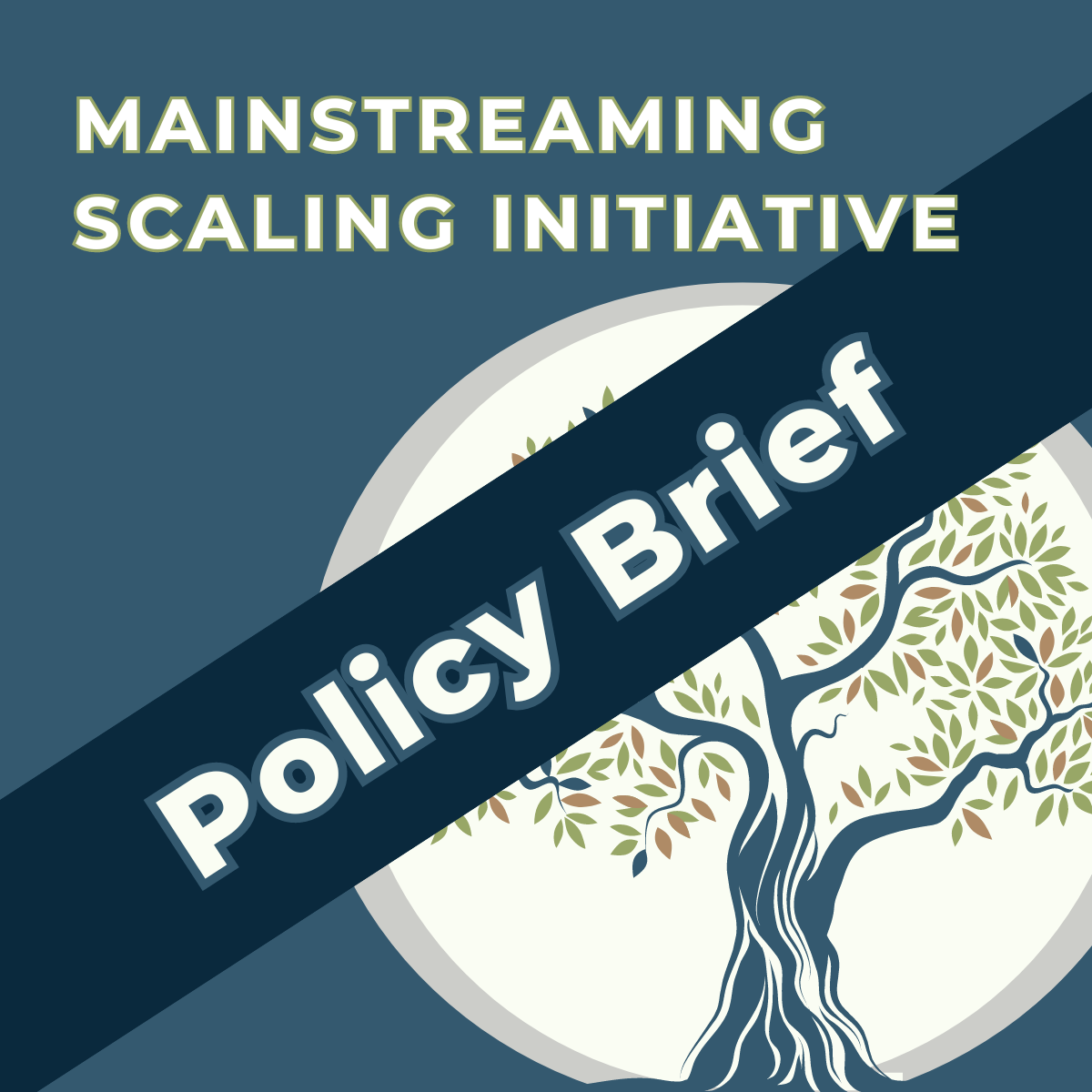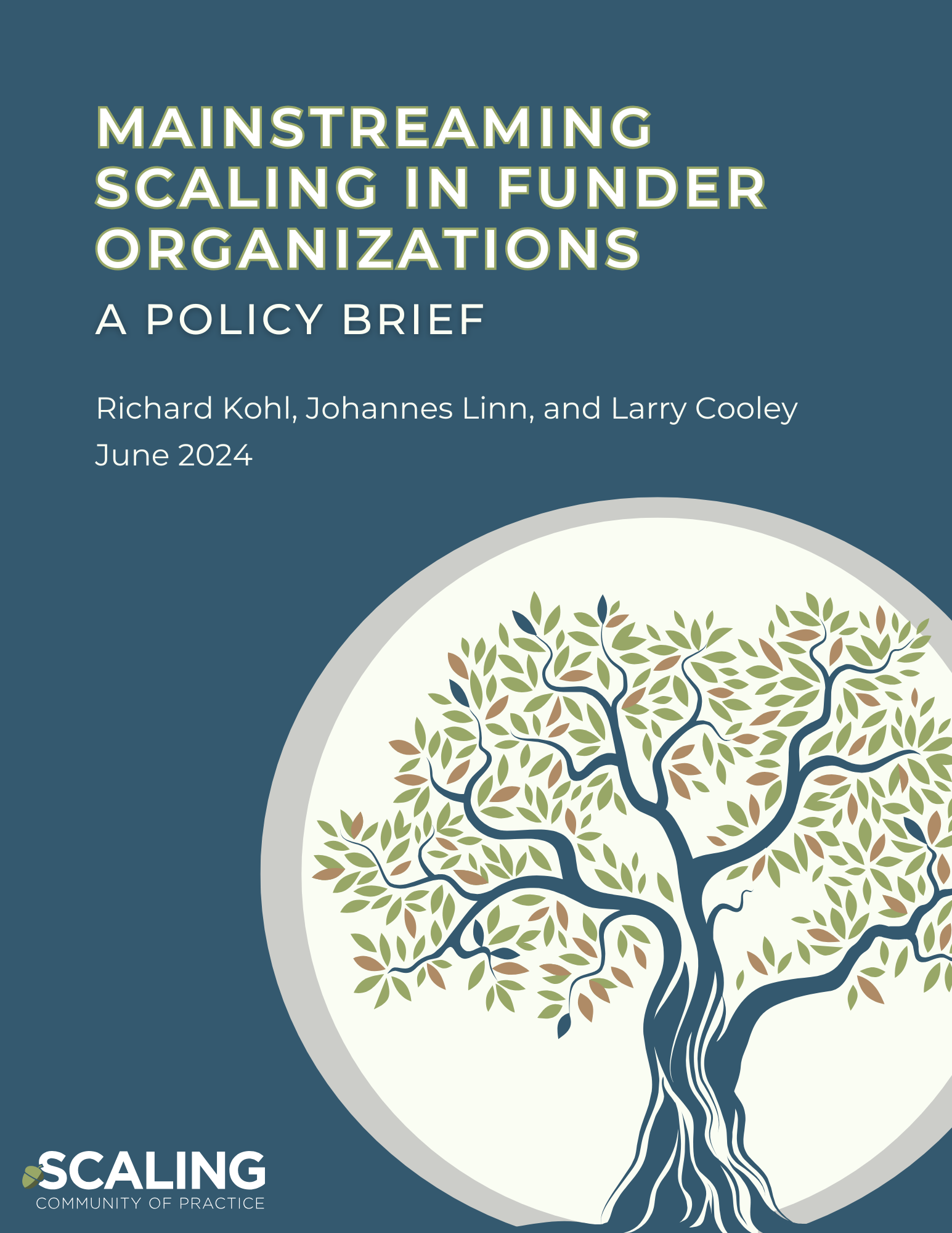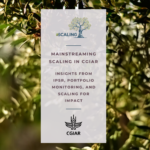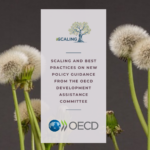
Abstract
Abstract This policy brief presents a summary of results from the first year of a two-year action-research initiative on mainstreaming scaling in funder organizations undertaken by the Scaling Community of Practice. It draws on a comprehensive, detailed interim synthesis report prepared by the authors and posted here. The initiative to date has completed 12 collaborative case studies of a wide range of selected development and climate funder organizations. The policy brief notes that scaling is increasingly being mainstreamed in funder organizations. It summarizes the principal findings on the enabling factors of mainstreaming scaling and on the extent to which key aspects of “good” scaling have been pursued in mainstreaming. It concludes with recommendations for individual funders and for the funder community as a whole.
CLICK HERE TO READ MORE
Acknowledgements
The Scaling Community of Practice and the authors are indebted to the colleagues from the funder partner organizations that participated in this initiative with case studies and in commenting on the findings. They also wish to express their special thanks to the Agence Française de Développement and to Eric Beugnot for the financial support extended to make this initiative possible. They also thank Charlotte Lane for her editorial support in finalizing this paper. The authors bear sole responsibility for the contents of the paper.
Introduction: Motivation and Design of the Mainstreaming Initiative
The world faces great development and climate challenges which require action that achieve sustained impact commensurate with the global scale of the problems. The pursuit of international development and climate interventions with sustained impact at scale in turn requires a shift from prioritizing innovations and the immediate outcomes of projects and programs to increasing the capacity to deliver long-term sustainable impact that addresses a significant portion of the global problem.
Scaling development impact – i.e., improving long-term impact-cost ratios in a way that addresses a significant portion of the global problem – is increasingly being turned to help achieve the Sustainable Development Goals (SDGs) by 2030. With progress towards the SDGs faltering, there are not sufficient resources committed to achieving the SDGs. Given the size of the funding gap, it is highly unlikely that the needed resources will be forthcoming. So we need to achieve more with the money we have. Scaling is part of the solution if it involves economies of scale, scope and continuity of engagement in pursuit of sustainable impact at scale so that greater results can be achieved with existing resources. If, as it is often understood, scaling just means more money for larger projects, this will not solve the problem.
In this context, in early 2023 the Scaling Community of Practice (SCoP) launched a two-year action-research initiative on mainstreaming scaling in international development funder organizations. The study focuses on funders with a known interest in systematically integrating, i.e., “mainstreaming,” scaling into their funding modalities. The purpose of this initiative is threefold: assess progress to date, develop lessons learned, and disseminate those lessons to encourage and inform further mainstreaming by interested organizations. The initiative focuses primarily on funders because of the considerable influence they have on what gets done and how it gets done. The reason for considering whether and how funders mainstream scaling is that with their financial and technical support they have considerable influence on whether and how innovations and development programs are scaled by innovators and development actors.
To achieve its goals, the initiative organized 12 case studies during its first phase (2023). The organizations covered (see Annex) include: (i) large bilateral and multilateral donors that mostly fund (and sometimes implement) development projects; (ii) vertical funds that focus more narrowly on specific sectors or subsectors; (iii) research and innovation organizations and innovation funders; (iv) international non-governmental organizations (INGOs) that implement donor projects; and (v) small foundations. The case studies were either written by people within those organizations, with support from the SCoP, or written by SCoP members, with support from the organizations. To frame these efforts, we used as guidance the results of prior research on good practice in scaling, as defined in the SCoP’s Scaling Principles. The studies explored six areas: (i) reasons the organization pursued mainstreaming (i.e., the drivers); (ii) specific forms of mainstreaming adopted; (iii) areas where progress was (not) made; (iv) challenges that arose and how were they addressed (or not, i.e., blind spots); (v) future plans for further mainstreaming and recommendations for the organization; and (vi) lessons learned for other organizations contemplating mainstreaming or wishing to progress further. This paper provides a high-level summary of the key findings and lessons learned from these initial twelve case studies. A comprehensive and detailed assessment of findings and lessons is contained in the Interim Synthesis report.
Given the small sample and other issues, the findings, lessons, and recommendations offered in this report are preliminary and tentative. These cases are not a representative or random sample, but are examples from organizations willing to participate in this study. Furthermore, the case studies are not formal evaluations of scaling performance, but qualitative reviews of the mainstreaming journeys of the partner funder organizations engaged in this initiative. To confirm and expand on these findings, research will continue under the Mainstreaming Initiative for a second year. We, the authors, welcome all comments and reactions by readers.
Mainstreaming a Systematic Approach to Scaling in Funder Organizations
Progress on mainstreaming has been stronger for private and smaller funders than for larger official funder organizations. Substantial progress has been made in several organizations, mostly private funders that are either foundations, vertical funds, innovation funders, or INGOs. By contrast, the larger official funder organizations, such as bilateral or multilateral donors, generally have made less progress. This difference is only partly explained by organizational size. We hypothesize that smaller organizations and private foundations and INGOs are more flexible and nimble. It seems that bureaucratic hurdles are lower and the organizational incentives to pursue scaling are more aligned for private funders and for single-issue organizations whose mission it is to have impact on that issue at scale. Several of these organizations have, for example, supported the transition to scale, attempted to strengthen local institutions, and fostered an enabling environment to support scaling, even though their resources are more limited than those of the large official funders.
Large official funders focus on ensuring that each individual project is effective and thus emphasize accountability and impact at the project-level, but generally they do not support long-term sustainable impact at scale. This finding highlights the difficulty of mainstreaming scaling using the one-off project model still prevalent among the official funders. They focus on specific, narrow, time-limited objectives, on intermediate outputs and on disbursements rather than on long-term sustainable impact. Add to this a high degree of risk averseness, a proliferation of project objectives and resulting complexity, rigid bureaucratic requirements and incentives that reward project approval by the Board rather than long-term success, and it is not surprising that project teams focus mostly on short-term deliverables rather than sustainable impact at scale. The large official funders make significant investments in the policy enabling environment, institutions, market systems and infrastructure, but these too tend to be one-off and are not effectively coordinated or aligned with scaling efforts under investment projects. The fact that such reform efforts also are often not grounded in national ownership reduces their impact and sustainability.
By far the most important driver of mainstreaming is leadership by senior management of the funder organization. For mainstreaming to succeed, leaders must act as champions and drive an organizational change process, beginning with the inclusion of scaling in the organizational mission, vision, and current strategy. Because mainstreaming requires several years, it needs continuity of leadership; where and when this does not occur, mainstreaming easily stalls or even reverses. Pressure from governance bodies, i.e., boards or external funders, sometimes plays a significant role, in particular when they assure accountability and continuity of engagement by senior management with the scaling agenda. Internal or independent evaluations of scaling performance, examples from similar organizations, and bottom-up pressure from staff also facilitated mainstreaming, but are not of the same importance as leadership.
Mainstreaming requires sustained action by funder leaders across many areas of institutional change, some of which are more prevalent in practice than others. Leaders have to design and manage a complex and long-term process of institutional change if they want to mainstream scaling in their organization. The most important part of that process is bringing middle management and staff on board in implementing the mainstreaming effort. Without their active support mainstreaming efforts will be severely constrained as some of the case studies demonstrate. Common forms that mainstreaming takes in the case studies are: (i) integration of scaling into organizational missions, visions and multi-year strategies; (ii) development of internal scaling frameworks, guidelines and tools/toolkits; (iii) a focus on partnerships as the core and primary approach to scaling; and – especially for larger funders – (iv) investing in strengthening public sector institutions and enabling environments or market systems in recipient countries, i.e., systems change.
The prevalence and effectiveness of several other important aspects of mainstreaming are quite mixed. Very few organizations dedicate human or financial resources or specialized organizational units to support preparing innovations or projects for scale. In the few cases where such resources exist, they are quite modest. This tends to slow or limit the effectiveness of the mainstreaming effort. Innovation funders and other private funder organizations are generally more advanced compared to the larger official funders in several areas: (i) integrating scaling and scalability assessments into their design, review, and approval process, often from the early stages of research and development or design; (ii) affecting changes in internal culture and incentives that encourage application of scaling; and (iii) integrating scaling-relevant indicators into monitoring, evaluation, accountability and learning (MEAL) frameworks.
In principle, funders exist in all of the phases from innovation/intervention to scaling, but in practice gaps remain. Larger official funders and their projects often work at scale and have the resources to create the foundations for scaling and take projects and innovations to scale. In practice, they have little or no systematic connection to their own innovation units or labs, let alone other innovation funders. Because of these gaps in funding, the “valley of death” along the scaling pathway remains a problem despite the progress made on mainstreaming scaling. To help bridge these gaps, much more needs to be done by funders in mainstreaming scaling into their operational practice, esp. among the larger official funder organizations.
Integrating Good Scaling Practices in Funder Organizations
In mainstreaming scaling, it is important that good scaling practices are applied. It is not enough for funders to focus on scale and scaling. They have to do so in the right way. Fortunately, there is now lots of evidence on what represents good scaling practice.
A clear definition of scale and scaling as transformational, not transactional, is an important prerequisite for effective support for scaling, but many funders continue to focus explicitly or implicitly on transactional scaling. Many funder organizations, and especially the larger project funders, have not established clear internal definitions of scale, and the tacit definition continues to consider scaling as “doing more” – more resources, larger projects, more co-financiers. We define this as “transactional scaling,” where success is measured in terms of the scale of funding and results achieved by a project’s end, with impact usually expressed against a baseline rather than relative to the size of the problem. By contrast, some smaller funders and innovators have moved towards what we refer to as “transformational scaling,” which targets delivering long-term sustainable impact at large scale beyond a project’s lifetime. Transformational scaling emphasizes a viable business or funding model and adequate resources for ensuring ongoing delivery of goods and services over time, with one or more implementing organizations having the necessary mandate, capacity, and reach to continue to implement at scale when external funders depart. Transformational scaling is usually accompanied by a significant effort at sustainable systems change to strengthen capacity, the policy enabling environment and, where appropriate, market systems. The success of transformational scaling is measured in terms of results and impact relative to the size of the problem (the denominator), not against the baseline
Almost all organizations integrate equity and inclusion, as well as several other cross-cutting issues like gender, climate change, and youth, into their overall work and into scaling, but with insufficient attention to tradeoffs. Most funders feel obliged to include multiple objectives and cross-cutting themes without consideration of the tensions between them, which means that tradeoffs cannot be effectively managed to achieve optimal scale. Moreover, the resulting extra time and resources required and administrative complexity of project design tends to interfere with a systematic scaling effort. Taken together these pressures push project teams back into a transactional scaling mode and make them resistant to taking on scaling as yet another ‘unfunded’ mandate. Instead they focus mostly on achieving whatever results are expected by project end, but do not consider how to create the conditions for sustained scaling beyond. A more explicit focus on how to achieve optimal scaling (where decisions about tradeoffs between scale and other objectives are clearly made) will therefore be important in future.
Many funders pursue a localization agenda, but do not make the explicit link to scaling. Localization can support scaling by prioritizing the concerns of local stakeholders, emphasizing the role of indigenous institutions, and allowing for better alignment with local constraints. But this requires inclusive planning processes beyond consultation and alignment with real priorities and not just formal strategy and policy documents. Many larger funders have decentralized their operations to in-country offices, facilitating local alignment, establishing long-term relationships, and increasing the opportunity for local ownership, while decentralization is difficult for smaller funders organizations. In any case, on its own decentralization, while potentially supportive of localization and scaling, is not enough. Local managers and staff need to have clear incentives, processes and resources to localize and scale. In practice, greater local autonomy can even conflict with the ability of headquarters to implement organization-wide changes such as mainstreaming of scaling.
Funders, large and small, recognize in principle the importance of partnerships, but have difficulty in practice finding or engaging with partners on a sustained basis in support of transformative scaling. One reason is that many funders overlook the substantial time, effort and resources required to create, implement and maintain partnerships. These partnerships also imply some sacrifice of autonomy by each partner. For the larger official organizations, partnerships are often linked with transactional scaling, i.e., bigger projects and a narrower focus on achieving project goals. Private funder organizations, including the smaller innovation funders and the larger INGOs, desire partnerships that are more transformational. They see partnerships primarily as a mechanism for hand-off to larger organizations that will take projects and innovations to scale; but they often have difficulty in developing and sustaining transformational partnerships with larger funder organizations, governments, and major corporations due to a lack of interest among potential partners and the absence of intermediary organizations that might facilitate hand-off.
Funders can and should act as intermediaries in providing the resources and performing other functions needed to take innovations or projects to scale, but they often do not fill this important role. Nor, in most cases, do they invest in creating or strengthening national or regional intermediaries for scaling in key sectors. As a result, despite considerable progress in mainstreaming, a lack of scaling intermediaries remains a major gap in the scaling ecosystem. This adversely affects the prospects for partnerships as well.
Challenges, Tradeoffs and Tensions
During mainstreaming, organizations face several challenges, tradeoffs and tensions that they need to – but more often fail to – address explicitly. Some of those tradeoffs and tensions were discussed above, particularly the tradeoffs between equity and inclusion versus scale, and the costs of partnerships. Several other important tensions are:
- Maximizing impact versus scalability. Projects and innovations are often designed by technical experts responding to multiple objectives, especially maximizing immediate effect. As such, they are often comprehensive and include multiple best practices in the sector. However, complex, multiple-component designs usually have high unit costs, require sophisticated human and other resources that are often not available at scale, and involve multiple agencies and stakeholders, creating coordination challenges. These factors make interventions less scalable. Simpler, less-costly designs with more modest impact often have greater potential for sustainable impact at large scale,
- Risk aversity in transactional scaling versus embracing risk in transformational scaling. Many funders measure project success based on accountability, disbursements and outputs achieved, whereas transformational scaling targets sustainable impact at scale. Trying to achieve the latter is inherently riskier in terms of individual projects or innovations. Many funder organizations, especially among the official funders, have to aim for high project success rates due to the expectations of their political authorities and taxpayers, irrespective of impact at scale. A shift to transformational scaling requires reframing risk and return goals and definition and measurement of success towards looking at overall institutional impact on sustainable development from a portfolio perspective.
- Scaling versus systems change. Systems change is often necessary to remove constraints to impact at scale, and can also create additional space for scaling, increasing potential impact and scale. However, strengthening or creating institutions and enabling environments can take substantial time, effort and resources, and requires sustained engagement and relationships with local stakeholders and political economy issues. Moreover, systems, especially market systems and value chains, are often specific to individual subsectors and types of innovations or projects. Diverse interventions can require distinct scaling pathways (products vs. services vs. good practices) and implementation mechanisms at national, regional and local levels. So finding the right balance between support for scaling and for system change is an important challenge for funders to consider.
Preliminary Lessons for Individual Funder Organizations
There are four basic requirements for effective mainstreaming:
- a long-time horizon (10-15 years);
- senior leadership to drive and champion the process;
- a clear vision of how scaling fits into the organization’s work, mission and strategy; and
- a clear definition of what scaling/scale means for the organization and its role in the scaling ecosystem: does it support innovation, transition to scale, institutionalization of scaling, or some combination of the above?
The definition of scaling must be one that focuses on transformational, not transactional scaling. In this regard, funders that use the project model as their primary operational instrument need to modify that model to facilitate scaling. The transactional project approach may have made sense decades ago when large infrastructure investments dominated the portfolio of funders, especially of multi-lateral development banks. However, this approach, which has an underlying vision of development as engineering and technical solutions and project goals as one-off outputs rather than sustainable development impact, cannot and will not support scaling. If the project format is to be retained by most funders – as it likely will – it will need to adopt longer time limits that prioritize sustainability and scaling; use new instruments like programmatic or thematic approaches, results-based or multi-tranche financing; a focus from the start on enabling conditions and platforms for sustainable scaling; and project workplans and implementation modalities that allow for risk taking, learning and adaptive management.
Practical implementation of mainstreaming has several components that funders need to focus on. Ideally these components are part of an organizational change or change management strategy with clear objectives for what successful mainstreaming looks like and a commitment of financial, human and organizational resources to achieve them. These include:
integration of scaling goals and criteria into policies, processes and procedures, and operations generally;
technical and dedicated budgetary support for frontline teams; analytical tools, training and knowledge management for middle management, staff, consultants, and local counterparts/implementing partners;
incentives for management and staff to integrate scaling into their work, adopt scaling definitions, and apply scaling tools and frameworks;
monitoring and evaluation of the mainstreaming approach and its impact; and
integration and coordination of investments in scaling with systems strengthening.
Monitoring, evaluation, accountability and learning (MEAL) are particularly important in mainstreaming scaling and in providing the information needed at all phases of scaling. This includes: collecting data on pilots and innovation to assess and improve scalability; understanding the role of context and the political economy of stakeholders; monitoring progress of scaling strategy implementation and investments in systems change; and assessing impact at scale, especially long-term sustainability. Integration of scaling indicators into project and organizational goals, key performance indicators, and individual staff performance metrics are critical to effective mainstreaming of scaling. Without incentives and accountability, management and staff are likely to comply with scaling as merely another check-the-box exercise akin to other cross-cutting mandates.
Recommendations for the Funder Community
There is a need for greater focus by the funder community on filling the intermediation gap in innovation or project scaling pathways, i.e., being responsible for taking innovations, interventions or projects to scale. Despite the significant progress on mainstreaming found in many of the case studies, there remains a major gap in the scaling ecosystem in terms of the intermediary function. Smaller funders do not have the resources, and frequently not the mandate, to scale. Larger funders have the resources, but often do not do so systematically nor have they institutionalized relationships with smaller funders and innovators for hand-offs from such organizations (if they even see themselves as playing that role). And, neither group has systematized its procedures for engaging with scaling partners or with governmental and private sector actors able to sustain programs over time. Intermediation often falls between the cracks since it does not directly translate into measurable achievement in direct funding of innovations, outcomes or impact. It is a quasi-public good that will enhance scaling for all actors but individual funders have rarely been willing to invest in creating or sustain intermediation capacity for the benefit of international development writ large.
We conclude with seven specific and interlocking recommendations for the funder community:
- shift from a transactional to transformational approach to scaling, and put in place the internal organizational changes necessary to affect that change; and take specific steps to ensure that large funders in particular, including bilateral and multilateral funders and large foundations, focus on transformational scaling in key areas of global development and climate change (e.g., the World Bank in the pursuit of its newly created Global Challenge Programs);
- create formal mechanisms and institutions to facilitate linkages between small donors, innovators and innovation funders, larger funders, and long-term service providers;
- invest more resources in funds that internalize these intermediary functions for particular sectoral or thematic areas, such as the International Fund for Agricultural Development (IFAD) and the Global Financing Facility (GFF);
- invest greater resources in the creation and strengthening of country-led, inclusive country and regional platforms, such as the country platforms under the Just Energy Transition Partnership (JETP) or regional donor consortia or organizations like the Alliance for a Green Revolution in Africa or the Central Asia Regional Economic Cooperation Program;
- integrate scaling into widely used MEAL frameworks such as the Organization for Economic Co-operation and Development’s Development Assistance Committee (OECD-DAC) evaluation guidelines as this can potentially have a multiplier effect beyond bilateral and multilateral funders; and
- integrate scaling into the global development effectiveness agenda to encourage funder organizations to set quantitative targets for their contributions to impact at scale in the Sustainable Development Goals (SDGs) or other global goals, such as for carbon emissions reduction or biodiversity protection. Taking on a proportionate share of responsibility among various global players could create powerful incentives.
Annex
Table 1. Case studies completed and ongoing under the Mainstreaming Initiative(All case studies are posted here: https://scalingcommunityofpractice.com/resources/case-studies/) |
||
| Organization | Type of the funder organization | Case Study Status |
| Phase 1, 2023 | ||
|
Large bilateral official funder of institutional and systems strengthening; broad sectoral/thematic coverage | Posted |
|
Large international NGO; broad sectoral/thematic coverage | Posted |
|
Large multilateral development bank for Latin America; broad sectoral/thematic coverage | Posted |
|
Vertically integrated research/implementation of fortified food | Posted |
|
Small multilateral official funder; focused on vertically integrated research/implementation of fortified food | Posted |
|
Medium-sized multilateral official funder; focused on agricultural development, especially for small family farmers | Posted |
|
Small foundation focused on innovation and scaling of agricultural and rural development innovations | Posted |
|
Department of a large bilateral official funder; focused on innovation and scaling in agriculture and food systems | Posted |
|
Small bilateral official funder of innovation and scaling of health sector solutions | Posted |
|
Small multilateral official funder of innovation and scaling private for private enterprises; affiliated with IDB. | Posted |
|
A multilateral international agricultural research organization | Posted |
|
Large international NGO; broad sectoral/thematic coverage | Posted |
|
Review of funder practices in the education sector | Posted |
| Phase 2, ongoing | ||
|
Large multilateral development bank for Africa; broad sectoral/thematic coverage | June 2024 |
|
Small multilateral funder of maternal and child health and nutrition interventions and system strengthening; affiliated with the World Bank | June
2024 |
|
Small Foundation; funding nutrition research and advocacy | June
2024 |





